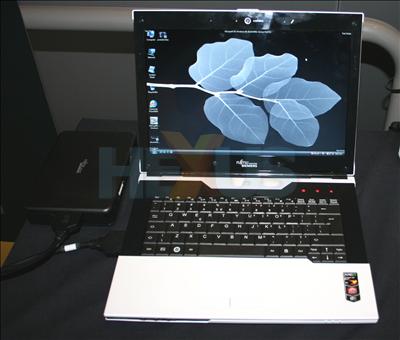What do we think
There is a lot to take in here, from a revised, power-efficient processor to a mobile chipset based on the 780G logic.The technical analysis shows that AMD won't win the pure CPU fight; Intel's Penryn-based mobile CPUs are faster, so any CPU-centric tasks will be better-suited to a high-end Centrino platform.
AMD knows this and is positioning Puma as a complete solution, rather than components that should be evaluated on an individual basis.
Still, a bunch of present applications demand CPU power, so is the Turion X2 Ultra good enough? Notice the use of the word 'good' and not 'fast'? The answer, we reckon, is yes. It may not be massively faster than the Turion X2 64 that it replaces, but it has other virtues, such as a design that pays particular attention to power-saving when the core(s) are not fully loaded.
The M780G chipset is the real jewel in the Puma crown. We find it hard to find significant and serious fault with it: the IGP is comfortably the fastest ever released for a mobile environment, the multimedia feature-set is strong, and outputs are excellent. Inbuilt technologies such as PowerXpress and Hybrid CrossFireX hasten to broaden its appeal, too.
We like the fact that laptop manufacturers can choose the WiFi adapter of their choice, without risking the pecuniary disadvantages that arise from not going all-Intel route with Cetrino. Is this approach better from a performance standpoint? AMD reckons it is, but only hands-on testing will verify this bold claim.
AMD has raked in over 100 design wins for Puma, and our technical investigation shows why. It's a complete platform that, on the face of it, has every major base covered.
Puma, then, is a solid upgrade from Kite Refresh in almost every respect, and, given an identical budget for the guts of the system, we'd have it displace Intel's current Centrino incarnation, Santa Rosa refresh, as our laptop platform of choice.
Why? Puma is simply more feature-rich and forward-looking than incumbent Centrino. It has an equivalently-performing CPU (given the price), far better integrated graphics that allow for playable frame-rates in modern 3D games, and UVD to help with HD content decode.
That may, and could, change with the introduction of now-delayed Centrino 2 (previously known as Montevina) in August, but it would be remiss of us to conjecture on the abilities of Centrino 2, which are reckoned to be similar to Puma's, before it's officially announced.
In summary, AMD's engineering team have done an excellent job in architecting Puma, but it will be up to the public to understand and appreciate that there's now a real choice. Centrino, whilst undeniably good, isn't the only option.
From a business perspective, AMD has a six-week window of opportunity to leverage Puma's worth. It absolutely needs to ensure that its partners have practically all the design wins available, from 12in sub-notebooks to 19in desktop replacements, ready to buy, before Intel comes marching in, with millions of marketing dollars to hand, and evangelises the merits of Centrino 2.
Puma-equipped laptops should begin to crop up at the usual band of etailers in mid-June. Any later and the Centrino 2 bandwagon will swallow what is, in essence, the best notebook platform from either manufacturer.
Bottom line: a mid-priced Puma laptop (£350) should provide adequate power for the casual gamer; decent battery life; and seamless, low-power playback of high-definition content. The gauntlet has been thrown down by AMD. We'll see if Intel has the necessary cojones to beat it with Centrino 2.
A Puma-powered Fujitsu Siemens Amilo 3650 on show. AMD needs its partners to roll them out quickly.














